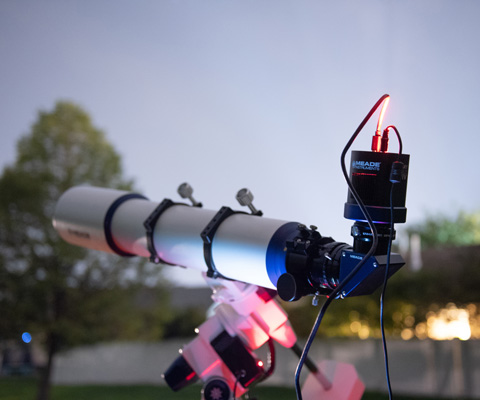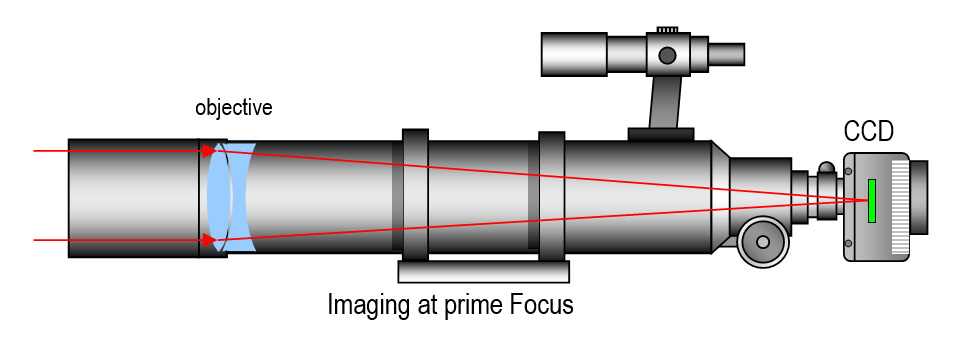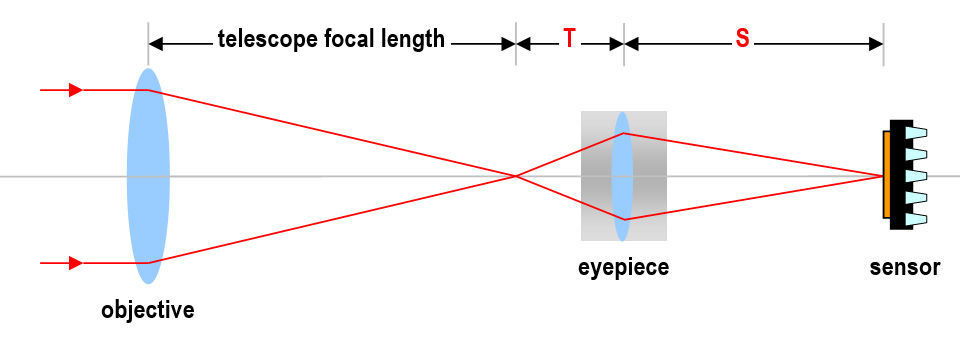Introduction
Images can be captured with a telescope in a number of ways, namely at Prime Focus, by Eyepiece Projection and by Afocal Projection also known as digiscoping. This article outlines the different methods and the relevance of focal reducers and barlows in this process.
The article also looks at the advantages and disadvantages of adopting a particular method and examines the pitfalls and benefits of using focal reducers and barlows/image-amplifiers with any of the projection methods mentioned in this article.
It is always a good idea to keep your imaging setup as simple as possible. Diagonals should not be used as they will introduce a light loss, may also introduce some small aberrations but most important make your whole setup more difficult to balance.

Image: Richard Keele.
Long imaging trains can also suffer from undesired movement and flexing which will typically produce soft and/or oblong stars, also reduce image contrast.
Projection at prime focus
Projection at Prime Focus is the preferred method for imaging and will produce the best results by keeping aberrations to an absolute minimum while allowing the maximum amount of light to reach the sensor.
Typically, there is nothing between the objective and the sensor. The objective lens/mirror will simply project an image directly on the sensor.
Assuming that there are no obstructions the size of the projected image will depend solely on the focal length of the telescope. The size of the projected image given a certain focal length and the size of a deep sky object in arcseconds can be calculated by the following formula.
Projected Image Size (mm) = angular size (arcseconds) x focal length (mm) / 4,144.0.0
Typically, the projected image will be considerably larger when compared to the typical sensor.
Barlows and image amplifiers
Barlow lenses and image amplifiers can be used to increase the focal length of a telescope and subsequently the size of the projected image. Barlows consist of two or in some cases three optical elements. Image amplifiers are more complex consisting of typically five or more optical elements offering better performance. On the other hand, the amount of light reaching the sensor will be decreased due to the additional glass.

High quality barlows and image amplifiers are very important in keeping aberrations to a minimum while not introducing new ones of their own.
Barlows and power-amplifiers are normally used for planetary imaging, when imaging deep sky objects of small angular sizes like the M57 (Ring Nebula) or when finer detail needs to be captured in larger nebulae and galaxies.
The final focal length of a telescope can be calculated using the following formula.
Resultant Focal Length = (telescope focal length) x (barlow/image-amplifier power)
For example, a Newtonian telescope with a focal length of 1000mm and a x2.5 barlow will have a resultant focal length of 2500m (1000 x 2.5).
Focal reducers
Focal reducers can be used to decrease the focal length of a telescope and subsequently the size of the projected image. Focal reducers typically consist of two or three optical elements and are very useful in deep sky photography to reduce exposure times while increasing the field of view to accommodate extended DSOs.
In some cases, focal reducers incorporate flatteners that will greatly reduce aberrations that manifest themselves closer to the edge of field. It is important to note that the type of focal-reducer/flattener must match the type of telescope. In other words, a focal-reducer/flattener designed for a refractor will not work well with an SCT scope.
The final focal length of a telescope can be calculated using the following formula.
Resultant Focal Length = (telescope focal length) x (focal reducer power)
For example, a SCT telescope with a focal length of 2000mm and a f0.6 focal reducer will have a resultant focal length of 1200m (2000 x 0.6).
Eyepiece projection
Eyepiece Projection is ideal when high magnifications are required beyond what barlows can manage, especially when imaging planets. In this method an eyepiece is used to magnify the projected image, this method is not recommended for deep sky imaging as the resultant focal ratios are rather slow.
The resultant focal length of a telescope can be calculated using the following formula.
Resultant Focal Length = (telescope focal length) x A
where amplification A = ( S – F2 ) / F2
S = distance form the last eyepiece lens to the sensor
F2 = eyepiece focal length
The following also applies: 1 / eyepiece focal length = (1 / S) + (1 / T)
The smaller the focal length of the eyepiece the larger the projected image will be. An eyepiece projection kit will also be required. These come in two size to accommodate 1.25” or 2” eyepieces.
Eyepiece projection kits will generally not accept oversized/wide angle eyepieces as these will not physically fit in the eyepiece holder due to their size. This is not important as the shorter focal length eyepieces which are better suited are typically small in size. Equally there is no benefit in using wide angle eyepieces when imaging planets.
The quality of the eyepiece is very important. For planetary imaging orthoscopic (Abbe design) eyepieces are very affordable and will easily outperform much more expensive general-purpose eyepieces, as such they are highly recommended.
Afocal projection
Afocal Projection involves the telescope, an eyepiece and a camera with its own photographic lens attached to the camera. Basically, the focal length of the camera is further extended by the telescope’s magnification.
Telescope Magnification = Objective Focal length / eyepiece focal length
The resultant focal length can be calculated by the following formula:
Resultant focal length = Telescope Magnification x camera lens focal length
For example, a telescope with a 1000mm focal length and 5mm focal length eyepiece will have a magnification power of x200 (1000 / 5). When used with a camera with a 30mm lens the resultant focal length will be 6000mm (200 x 30).
Points to note
For deep sky imaging Prime Focus imaging is ideal. If larger fields of view are required then focal reducers will have to be used keeping in mind that they may introduce vignetting in some cases.
If smaller fields of view are required good quality barlows and image amplifiers will work best. Ideal when imaging parts of the moon or the Sun.
Eyepiece Projection will work very well for high magnification planetary work using simple ‘bright’ eyepieces like Super Plossl and Abbe type orthoscopic eyepieces in particular fro maximum quality.
Afocal Projection is ideal for terrestrial photography, it is also applicable to planetary imaging with eyepieces with longer eye reliefs which can be employed to prevent vignetting. It is worth keeping in mind that there is a lot of glass between the objective and the sensor, typically 10-12 lenses when using an Abbe eyepiece with a fixed photographic lens and around 15-17 lenses when using a zoom type lens.
Conclusion
Ideally you would image at Prime Focus and simply employ focal reducers, barlows and image amplifiers when you require a different field of view. These arrangements keep the focal train short which is useful when balancing your scope. They will also offer the brightest images keeping the amount of glass employed to a minimum. Always use good quality barlows (ED) and power amplifiers to minimise false colour which can become a serious issue.
Related topics:
how-to guide, astrophotography, article








